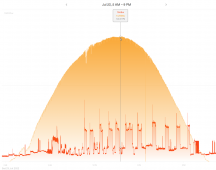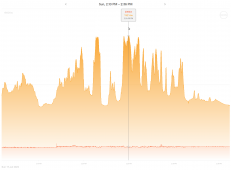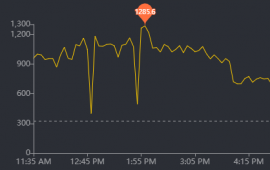svetz
Works in theory! Practice? That's something else
I don't know that it's good to mix the Hoymiles into an IQ8 array. As the IQ8s will supply the phase they should output power just fine. But getting power is only one part of it. While connected to the grid I wouldn't expect any problems.
But, there might be some issues to think about while off-grid.
I suspect you're thinking as many do, that the IQ8s are throttling via frequency shifting. It's true they support UL1741 and the power company can throttle them that way. If the Envoy controlled the IQ8s via frequency shifting, you'd be correct that mixing the two would be fine.
But, I suspect if you check the frequency you'll see it's not shifted when they're throttled under Envoy control. Off-grid with my IQ7s throttled back, I still see a frequency of 60 Hz, so suspect they are controlled via powerline rather than frequency shifting. This makes sense as the throttling needs to occur very fast to control surges, far faster than a couple of cycles.
I can see where you might be able to engineer around this. I believe the Envoy figures out how to throttle down based on voltage and the CT readings, so even though the Hoymiles are at full power the IQ8s may still throttle down accordingly. If your Hoymiles add-on is engineered such that it never exceeds the minimum power consumption then no worries about that. Similarly, if the IQ8s throttle down to zero then the Hoymiles should flip off via UL 1741. So that seems okay too. Can't wait to see what you find.
Which leaves the surge issue. This is a big unknown for me and may or may not even be an issue. I don't expect this to be a big puff of smoke, it'll more likely be a silent and slow killer of all the electronics (but it would only be a problem off-grid, which probably isn't that often). Surges occur when devices (like your air conditioning) turn off. The power input needs to throttle back instantly and the surge needs to be absorbed. Off-grid inverters and generators are all designed to handle the surge for the power that they can generate (as they aren't designed to operate in tandem with other power sources there's no need to handle anything bigger). That is a 5 kW generator can handle 5 kW of energy switching. Not an EE, so hopefully did some justice to the explanation.
The reason why there are maximum limits to the number of IQ7s an IQ8 battery can handle is the IQ8s handle what they can produce, plus a little more to accommodate about 1.4 IQ7s. The IQ8s should therefore be able to handle so many watts of energy from the surge potential created by the Hoymiles. So, again possible with some careful engineering.
Update: Just occurred to me you might be planning to do solar shedding (e.g., relay to turn off the Hoymiles while off-grid) to avoid problems or right-size the engineering.
But, there might be some issues to think about while off-grid.
I suspect you're thinking as many do, that the IQ8s are throttling via frequency shifting. It's true they support UL1741 and the power company can throttle them that way. If the Envoy controlled the IQ8s via frequency shifting, you'd be correct that mixing the two would be fine.
But, I suspect if you check the frequency you'll see it's not shifted when they're throttled under Envoy control. Off-grid with my IQ7s throttled back, I still see a frequency of 60 Hz, so suspect they are controlled via powerline rather than frequency shifting. This makes sense as the throttling needs to occur very fast to control surges, far faster than a couple of cycles.
I can see where you might be able to engineer around this. I believe the Envoy figures out how to throttle down based on voltage and the CT readings, so even though the Hoymiles are at full power the IQ8s may still throttle down accordingly. If your Hoymiles add-on is engineered such that it never exceeds the minimum power consumption then no worries about that. Similarly, if the IQ8s throttle down to zero then the Hoymiles should flip off via UL 1741. So that seems okay too. Can't wait to see what you find.
Which leaves the surge issue. This is a big unknown for me and may or may not even be an issue. I don't expect this to be a big puff of smoke, it'll more likely be a silent and slow killer of all the electronics (but it would only be a problem off-grid, which probably isn't that often). Surges occur when devices (like your air conditioning) turn off. The power input needs to throttle back instantly and the surge needs to be absorbed. Off-grid inverters and generators are all designed to handle the surge for the power that they can generate (as they aren't designed to operate in tandem with other power sources there's no need to handle anything bigger). That is a 5 kW generator can handle 5 kW of energy switching. Not an EE, so hopefully did some justice to the explanation.
The reason why there are maximum limits to the number of IQ7s an IQ8 battery can handle is the IQ8s handle what they can produce, plus a little more to accommodate about 1.4 IQ7s. The IQ8s should therefore be able to handle so many watts of energy from the surge potential created by the Hoymiles. So, again possible with some careful engineering.
What's with all those screws on the bottom? The unit is outside in the weather... it should be super water-tight. Not crazy about the LED either. I'd pot around the edges, led, and all the screws.My new microinverters just arrived. Video (No ads)
Update: Just occurred to me you might be planning to do solar shedding (e.g., relay to turn off the Hoymiles while off-grid) to avoid problems or right-size the engineering.
Last edited:







